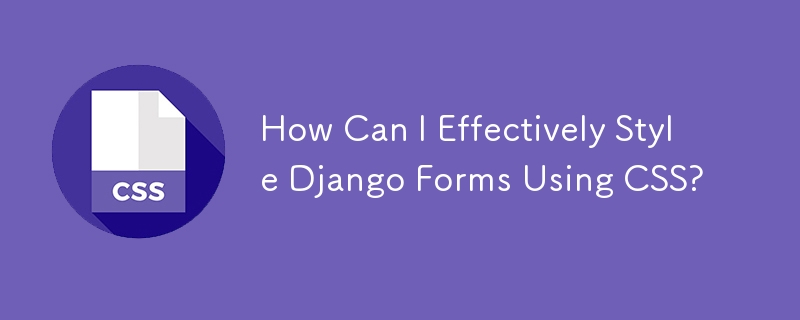How Can I Effectively Style Django Forms Using CSS?

Enhancing CSS Styling in Django Forms
In Django, forms play a crucial role in gathering user input. When it comes to styling these forms, CSS offers a powerful tool to enhance their appearance and usability. This article provides guidance on how to leverage CSS styling to customize the look and feel of Django forms.
Customizing Input Elements
To apply custom CSS styles to specific input elements, such as subject, email, or message fields, you can utilize the attrs attribute. By modifying the widget attribute of the field, you can assign CSS classes or IDs for targeted styling. Here are a few examples:
- Setting a class:
from django import forms
class ContactForm(forms.Form):
subject = forms.CharField(max_length=100, widget=forms.TextInput(attrs={'class': 'subject-class'}))
email = forms.EmailField(required=False, widget=forms.EmailInput(attrs={'class': 'email-class'}))
message = forms.CharField(widget=forms.Textarea(attrs={'class': 'message-class'}))- Setting an ID:
subject = forms.CharField(max_length=100, widget=forms.TextInput(attrs={'id': 'subject-id'}))Styling Options
With the appropriate classes or IDs assigned to input elements, you can reference them in your external CSS stylesheet to apply custom styling. For instance, to change the background color and border of the subject field, you could use the following CSS:
.subject-class {
background-color: #f0f0f0;
border: 1px solid #ccc;
}Form Rendering Methods
Django provides several methods for rendering forms, including as_table, as_ul, and as_p. These methods generate the HTML structure of the form. If you choose to use as_table, the form elements will be rendered within a table, making it easy to assign CSS classes to the table elements.
Additional Options
For more advanced customization, you can override the default rendering behavior by defining custom form fields or renderers. By extending the Field or Form classes, you have the flexibility to create your own rendering logic and apply CSS as needed.
The above is the detailed content of How Can I Effectively Style Django Forms Using CSS?. For more information, please follow other related articles on the PHP Chinese website!

Hot AI Tools

Undresser.AI Undress
AI-powered app for creating realistic nude photos

AI Clothes Remover
Online AI tool for removing clothes from photos.

Undress AI Tool
Undress images for free

Clothoff.io
AI clothes remover

Video Face Swap
Swap faces in any video effortlessly with our completely free AI face swap tool!

Hot Article

Hot Tools

Notepad++7.3.1
Easy-to-use and free code editor

SublimeText3 Chinese version
Chinese version, very easy to use

Zend Studio 13.0.1
Powerful PHP integrated development environment

Dreamweaver CS6
Visual web development tools

SublimeText3 Mac version
God-level code editing software (SublimeText3)

Hot Topics
 Vue 3
Apr 02, 2025 pm 06:32 PM
Vue 3
Apr 02, 2025 pm 06:32 PM
It's out! Congrats to the Vue team for getting it done, I know it was a massive effort and a long time coming. All new docs, as well.
 Building an Ethereum app using Redwood.js and Fauna
Mar 28, 2025 am 09:18 AM
Building an Ethereum app using Redwood.js and Fauna
Mar 28, 2025 am 09:18 AM
With the recent climb of Bitcoin’s price over 20k $USD, and to it recently breaking 30k, I thought it’s worth taking a deep dive back into creating Ethereum
 Can you get valid CSS property values from the browser?
Apr 02, 2025 pm 06:17 PM
Can you get valid CSS property values from the browser?
Apr 02, 2025 pm 06:17 PM
I had someone write in with this very legit question. Lea just blogged about how you can get valid CSS properties themselves from the browser. That's like this.
 Stacked Cards with Sticky Positioning and a Dash of Sass
Apr 03, 2025 am 10:30 AM
Stacked Cards with Sticky Positioning and a Dash of Sass
Apr 03, 2025 am 10:30 AM
The other day, I spotted this particularly lovely bit from Corey Ginnivan’s website where a collection of cards stack on top of one another as you scroll.
 A bit on ci/cd
Apr 02, 2025 pm 06:21 PM
A bit on ci/cd
Apr 02, 2025 pm 06:21 PM
I'd say "website" fits better than "mobile app" but I like this framing from Max Lynch:
 Comparing Browsers for Responsive Design
Apr 02, 2025 pm 06:25 PM
Comparing Browsers for Responsive Design
Apr 02, 2025 pm 06:25 PM
There are a number of these desktop apps where the goal is showing your site at different dimensions all at the same time. So you can, for example, be writing
 Using Markdown and Localization in the WordPress Block Editor
Apr 02, 2025 am 04:27 AM
Using Markdown and Localization in the WordPress Block Editor
Apr 02, 2025 am 04:27 AM
If we need to show documentation to the user directly in the WordPress editor, what is the best way to do it?
 Why are the purple slashed areas in the Flex layout mistakenly considered 'overflow space'?
Apr 05, 2025 pm 05:51 PM
Why are the purple slashed areas in the Flex layout mistakenly considered 'overflow space'?
Apr 05, 2025 pm 05:51 PM
Questions about purple slash areas in Flex layouts When using Flex layouts, you may encounter some confusing phenomena, such as in the developer tools (d...






